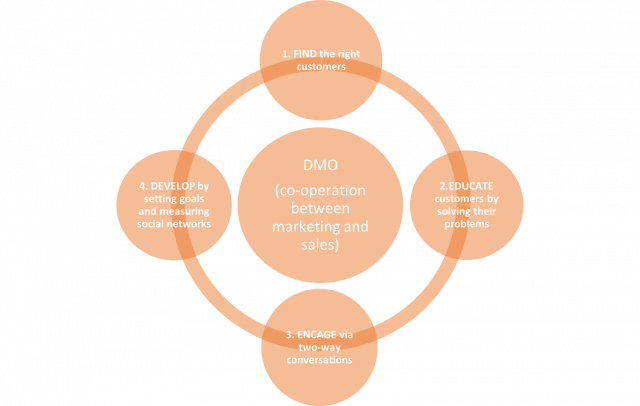How can Tourism Businesses successfully implement Social Selling?

Have you ever wondered what kind of new ways there are to benefit from social media? Or how tourism businesses could use social networks to engage with their customers even more? The key term in this text will be social selling. Social selling can be defined as a modern way to create and develop relationships with potential customers (Minsky & Quesenberry, 2016). Before getting there, we will familiarize ourselves with social media in business-to-business (B2B) marketing. This way, we can understand the important theoretical aspects of social selling. After that, social selling is utilized as a term and as a tool for tourism businesses to enhance their social media marketing.
B2B Social media marketing in a Nutshell
Social media has become a phenomenon of our time. It is inevitable that the role it has in terms of communication and marketing is increasing all the time. For a while now, the interest in using social media in B2B operations have increased. B2B marketing in social media is a tool for businesses where they can integrate already existing marketing strategies.(Bodnar & Cohen 2012, 3.)
Let us ask, why waste time on implementing already functional marketing strategy to social media? First, statistics show that average daily social media usage was 144 minutes in 2019 and global population usage was 49 percent (Clement 2020, “How much time do people spend on social media?”, para 1). It is clear how strong a platform it really is. Social media marketing can help businesses to do marketing in a smarter way when contributed well. With social media, businesses can reduce expenses, provide a clearer return of investment (ROI) and allow two-way communication between businesses and customers with more positive interactions. (Bodnar & Cohen 2012, 3-4: Agnihotri, Dingus, Hu & Krush 2015.)
Customer satisfaction and Information go Hand In Hand
Agnihotri et al (2015) emphasize the importance of information technology in their article. Using it together with sales technology will positively affect information communication. When a business has effective information communication it will generate responsiveness and customer satisfaction. To demonstrate this to practice, Agnihotri et al (2015) researched this theory by using data reports of sales professionals and implementing structural equation modelling. The key factor to achieve customer satisfaction is sharing information that is important for customers and delivers timely responses. Overall, the study indicates that social media indeed plays a major role when it comes to communicating information. To support this, a survey made by Statista confirms that social media have increased people’s access to information and made communication easier. (Clement 2020, “Global impact of social media”, para 1.)

Photo by Nikita Kachanovsky on Unsplash

How can tourism businesses succeed in Social Selling?
In order for businesses to succeed on social selling, Minsky and Quesenberry (2016) highlight the importance of co-operation between the marketing and sales team. The marketing department should train sales personnel to use social media effectively in different channels and to use social media software if the business has one. This way, sales personnel understand the social media guidelines and customers’ interest and needs when it comes to online content. The key objective to remember here is how Shanks summarized it: “Social selling is a team sport, not a showcase for great individual contributions”. (Shanks 2016, 1-5.)
Social selling is still unfamiliar phenomena in the tourism industry. This why it is vital to implement social selling studies and theories to help tourism businesses. The following framework is for tourism businesses who are new to social selling. It is created by using Shanks’ (2016, 57) guide for sales personnel. A DMO is used as an example but any tourism business can benefit from it.

Social selling framework
The important question when starting a social selling career is: who are my buyers? It all starts with customer information gathered by the company. A CRM software where all the buyer related information can be found is important. DMOs could use the information from CRM software to find the right audience on social networks. Great tool for this is LinkedIn Sales Navigator where you can easily highlight the potential buyers. (Shanks 2016, 72-75.)
Now we have found our customers. The next step is to provide them with the right kind of insight. According to Shanks (2016, 87) “buyers are looking for teachers or consultants, not order-takers or caretakers”. The goal is to solve the customer’s problems. This is exactly what a good DMO is all about. They are maintaining and developing destinations. To be successful, DMOs need to “teach” potential buyers about the destination and emphasize the right information to be an attractive destination for them. A great example of sharing educational content is Finnair’s Instagram takeovers by employees. Viewers get a real-life insight into different work positions around the organization.
Engaging is important in social selling. According to Nunan, Sibai, Schivinski & Christodoulides (2018) to understand customers, businesses should monitor social media comments. When approaching customers, they could generate surveys, share information about new product testings and of course, share stories (Nunan et al 2018). In addition, sales personnel should also use personal profiles to communicate and engage with customers in LinkedIn. It is the modern version of business cards after all. Last but not least, developing is required. Businesses need to always set goals. This way it is possible to measure if we are heading in the right direction. Monitoring likes, comments, shares, mentions and retweets is a must.
To sum up
Social selling is still an unknown term in the tourism industry. It has not yet been researched a lot. However, many studies indicate the importance of social media and creating close relationships with customers. This is where social selling comes in. It can be an asset for tourism businesses when used correctly. Businesses can make the most out of social selling by collaborating marketing and sales team together. In addition, they need to be active on their networks. It is vital to know what customers are talking about online. Two-way conversation is the key objective of social selling. Now, more than ever, it is important to engage with potential customers.
Acknowledgements
This blog post was written as a part of the Information Technology in Tourism Business course at the International Master’s Degree Programme in Tourism Marketing and Management (University of Eastern Finland Business School). Read more about the programme at https://www.uef.fi/tmm
References
Agnihotri, R., Dingus, R., Hu, M.Y & Krush, M.T. 2015. Social media: Influencing customer satisfaction in B2B sales, Industrial Marketing Management. 1-9. doi: 10.1016/j.indmarman.2015.09.003.
Bodnar, K. & Cohen, J. 2012. The B2B Social Media Book: Become a Marketing Superstar by Generating Leads with Blogging, LinkedIn, Twitter, Facebook, Email, and More. Hoboken, NJ. 3-10.
Clement, J. 2020. Daily social media usage worldwide 2012-2019. Retrieved October 29, 2020, from https://www.statista.com/statistics/433871/daily-social-media-usage-worldwide/.
Leung, D., Law, R., van Hoof, H. & Buhalis, D. 2013. Social Media in Tourism and Hospitality. A Literature Review, Journal of Travel & Tourism Marketing. 30:1-2, 3-22.
Minsky, L. & Quesenberry K.A. 2016. How B2B Sales Can Benefit from Social Selling. Harvard Business Review. 1-6. Retrieved from https://hbr.org/2016/11/84-of-b2b-sales-start-with-a-referral-not-a-salesperson.
Nunan, D., Sibai, O., Schivinski, B. & Christodoulides, G. 2018. Reflections on “social media: Influencing customer satisfaction in B2B sales” on a research agenda. Industrial Marketing Management. 1-7 doi: 10.1016/j.indmarman.2018.03.009
Newberry, C. 2019. Social Selling: What it is, Why You Should Care, and How to Do It Right. Retrieved October 31, 2020, from https://blog.hootsuite.com/what-is-social-selling/#care.
Shanks, J. 2016. Social Selling Mastery: Scaling up Your Sales and Marketing Machine for the Digital Buyer. John Wiley & Sons, Incorporated. Retrieved from https://ebookcentral-proquest-com.ezproxy.uef.fi:2443/lib/uef-ebooks/reader.action?docID=4648728.
- How can Tourism Businesses successfully implement Social Selling? - November 19, 2020